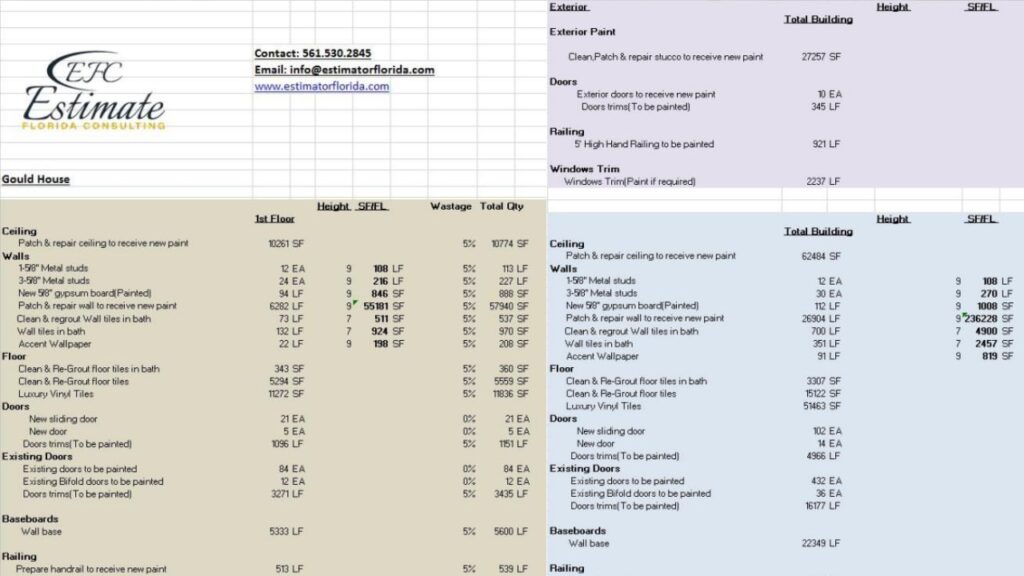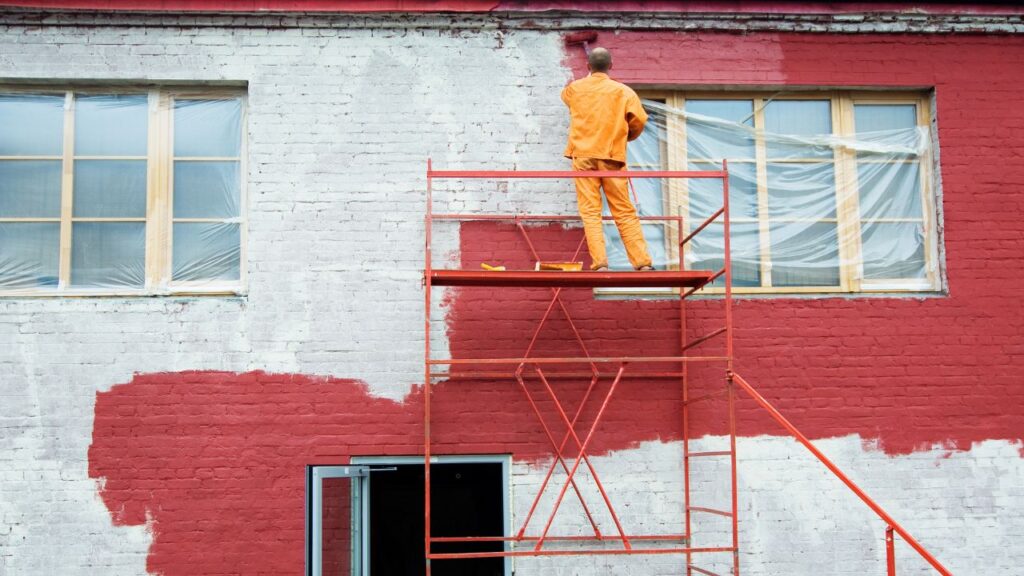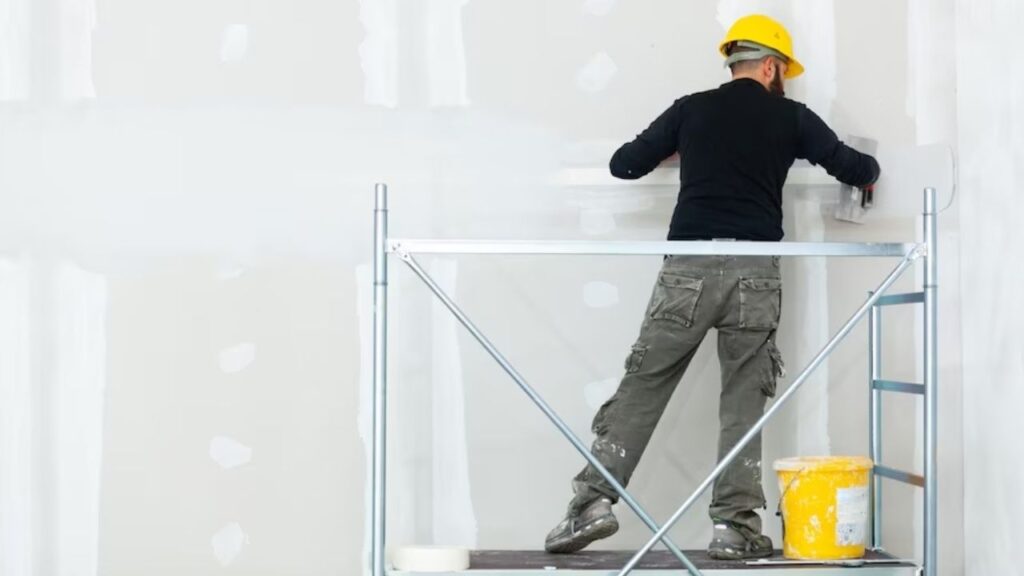A Wining Cost Estimate
That Helps You To Win More Painting Construction Projects

Painting Estimator: A Practical Guide
When it comes to painting projects, estimating the cost and time for the project can be overwhelming but, with a painting estimator, it becomes an easy task. Painting estimator is a tool that helps in calculating the required costs and time for completing a painting project. It calculates the estimate based on inputs such as room dimensions, paint type, labor charges etc.
Utilizing a painting estimator ensures accurate estimates for your project which helps in optimizing budget and time usage efficiently. The benefits of using this tool include getting precise projections without committing any errors in arithmetic calculations or overlooking expenses such as labor costs and paint quantity.
A crucial aspect of utilizing a painting estimator is ensuring to input all relevant data factors accurately. One tip involves adding 10-15% extra paint to accommodate unexpected requirements while another is to ensure all required measurements are taken thoroughly to avoid unnecessary expenses. Adequately utilizing this tool results in saving time and money whilst also getting precise costing estimates.
Get ready to estimate like Bob Ross on a painting spree with our complete guide to understanding painting estimator.

To understand painting estimator with its importance and benefits, you need to dive deep into this section. If you are looking for a more precise and quicker way of estimating painting costs, a painting estimator can be your best bet. The importance and benefits of painting estimator will help you determine how it can make your life easier and your work more efficient.
Painting estimator plays a crucial role in determining the cost of a painting project accurately. It helps to estimate the amount of paint required based on the area and surface condition to ensure timely completion within budget. By using an advanced painting estimator, one can avoid underestimating or overestimating project costs, making it essential for both homeowners and contractors.
Using a painting estimator helps in selecting the right product as well, thereby ensuring maximum efficiency and output. The tool also determines the duration of the project, aiding in efficient scheduling and reducing delays. Accurate estimation is necessary for staying competitive with other contractors while ensuring complete customer satisfaction.
The automation tool eliminates manual calculations and provides accurate results that are backed by scientific data. It helps to produce precise quotes for customers, reducing errors while boosting professionalism and trust. Without a reliable painting estimator, relying on guesswork can result in significant losses.
According to a report published by Technavio Research Analysts (2018), “The global painting tools market is expected to grow at a CAGR of around 5% during the forecast period.” This growth is fueled partly due to increasing demand from construction activities worldwide. Hence investing in a good quality painting estimator tool has become essential for companies looking to remain competitive in this expanding marketplace.
Get your painting estimates in just a few clicks: no more begging for quotes like a sad, paint-less puppy.

Painting estimator can provide numerous advantages for individuals and businesses. Here are some key benefits:
While it is one thing to keep these benefits in mind, it is also essential to choose the best painting estimating software that suits your needs.
A recent study by IBIS World showed that since 2016, the estimated annual revenue of the Painting Services market in the US was $41 billion.
Overall, painting estimator tools can improve your efficiency by creating accurate estimates quickly and assisting with planning and budgeting.
Get ready to paint the town…with numbers! This step-by-step guide to Painting Estimator will have you estimating like a pro in no time.
To understand stucco estimator with the two sub-sections, ‘Definition of Stucco’ and ‘Importance of Stucco Estimator’ is the solution you need. Knowing the definition of stucco is crucial as it lays the foundation for learning how to estimate its costs accurately. On the other hand, recognizing the importance of stucco estimator equips you with the tools to make informed decisions regarding a construction project.
To collect the essential information for your painting estimator, begin with a comprehensive analysis of the location that needs to be painted. Conduct a walk-through of the area and make an inventory of all the surfaces and objects that require painting, including their size and shape. Also, identify any details that may require special attention or modifications.
Next, decide on the type of paint to be used according to your client’s preference and budget. Determine how much you will need based on the surface areas to be painted and estimate how many coats are needed to complete the job satisfactorily.
In addition to assessing these basic parameters, it is critical to consider other relevant variables such as environmental factors like temperature and humidity levels that could impact paint application quality or timing. Such minute details can be incorporated in your estimation cost calculations.

Make sure you have all necessary information documented before estimating costs or providing quotations. Neglecting small details often ends up being costly mistakes for both you and your clients.
Remember that staying competitive means being efficient in both identifying project requirements correctly as well as keeping things organised throughout each stage of the project cycle. A thorough gathering of data at early stages not only allows better estimation but also smoothens out future project management activities ensuring building long-term good relations with customers efficiently.
Get ready to do some math, because calculating surface area is about to make you wish you paid more attention in geometry class.
To estimate the amount of paint required for a project, one must accurately determine the surface area that needs to be covered by the paint. This can be achieved through various methods of Calculating Surface Area.
Step 1: Measure the width and height of each surface to be painted, such as walls or ceilings, using a measuring tape.
Step 2: Multiply the width and height measurements together to get the total square footage for each surface.
Step 3: Add up all the individual surface areas to get a total estimated square footage for the entire project.
It is important to note that while calculating surface area, one should also consider any obstacles such as doors and windows that may not require painting.
To ensure accurate estimates in preparing your Painting Estimator, it is recommended to double-check all measurements and calculations before finalizing your figures.
Don’t risk wasting time and money on unnecessary paint supplies. By following these steps precisely, you can trust your Painting Estimator will provide an accurate prediction of what materials are needed for your next painting project.
Choose your paint wisely, because the wrong shade could turn your client’s dream home into a nightmare.

When deciding on the appropriate coating and resources for your painting estimate, it is essential to take into account different variables such as surface type, purpose of the room, and environmental conditions. To ensure high-quality outcomes, here are a few points to consider:
It’s crucial to note that each new coat reacts uniquely with surfaces; ensure that you employ an expert who understands which paints function best under specific conditions.
When deciding the kind of coat to utilize in a personal project of mine for a vibrant blue bedroom design theme, selecting paint hues that invited calming vibes were necessary. After doing research on popular colors pertaining to relaxation techniques like the “lilac grey” hue or pale shades of purples; I utilized eco-paints with coordinating tones for molding and accents with ease while staying within budget constraints.
Estimating labor costs is like trying to herd cats – it’s exhausting and unpredictable, but crucial for getting the job done right.
To estimate labor costs for a painting project effectively, it is important to consider various factors such as the number of workers required, their hourly rates, and the estimated time for task completion. The following steps can be taken:
1. Create a table using the, tags. Column headers should include the job task, estimated hours required for completion, hourly rate for each worker type (such as painters, prep workers, or supervisors), and total cost.
2. Add actual data to the table based on your specific project requirements.
3. Keep in mind that overtime pay and unforeseen events that require additional work hours can impact labor costs. Utilizing cost-tracking software may help with tracking progress and making any necessary budget adjustments.
4. To make accurate estimates, research industry standards, and speak with experienced professionals in the field to gain insight into realistic expectations and potential challenges that may arise.
5. Remember to factor in the cost of your sanity! Overall, by taking the time to carefully estimate labor costs, you can help ensure your painting project stays within budget while producing high-quality results.
Finalizing the Project Estimate
Once all the necessary information has been gathered and calculated, it is time to finalize the project estimate. This critical step ensures that costs are accurately projected and contingency funds are accounted for.
It is important to note that finalizing the project estimate should be done carefully and thoroughly. Any errors or omissions could result in cost overruns and negatively impact project profitability.
As part of this process, it may also be wise to review and adjust project timelines as necessary to ensure accurate estimates.
A former painting contractor once learned the hard way about the importance of finalizing estimates. He neglected to include a contingency fund in his project estimate, resulting in unexpected expenses that ate away at his profits. Since then, he has made it a priority to always finalize estimates with meticulously calculated contingencies.
Estimating the accuracy of a painting project is about as easy as predicting the weather in New England.
To ensure the accuracy of your painting estimates, you must consider multiple factors. In order to paint a reliable estimate, you need to analyze the surface condition, type of paint, complexity of the project, and labor rates. Each of these factors plays a crucial role in determining the overall cost of your project.
For the assessment of painting estimation, surface texture is an integral factor to consider. The uniformity and evenness of the surface play a significant role in determining the accuracy of the estimates.
The following table provides an overview of how different surface conditions may impact the overall painting estimation worksheet.
Surface Roughness | Impact on Painting Estimation |
Rough Surface | Increase in paint consumption due to irregularities. |
Smooth Surface | Lower paint utilization due to smooth edges. |
Nicotine Stained Surface | Increased preparation time and materials |

Apart from these factors, additional consideration is necessary for surfaces with an uneven coating or those that require priming before painting.
To achieve accurate estimates, one must also account for surface color variations, such as darker or lighter colors requiring additional coats and longer application periods.
Therefore, when dealing with a diverse range of surfaces, it is essential to have a consistent approach towards analyzing each condition’s unique characteristics before preparing the estimate.
To ensure more precise measurements, one could use digital devices such as infrared scanning tools or moisture meters to rule out any underlying defects or imperfections that would affect painting costs.
Choosing the right type of paint is like choosing a life partner – it’s all about the compatibility and endurance.

Paint Type is a crucial factor affecting the accuracy of painting estimator. Different types of paint are used for specific surfaces and projects. For instance, using oil-based paint on a surface that should be painted with water-based paint will lead to an inaccurate estimate.
Below is a table showing various Paint Types, their uses and characteristics:
Paint Type | Uses | Characteristics |
|---|---|---|
Oil-Based | Ideal for woodwork and metal surfaces | Durable, glossy finish, slow drying |
Water-Based | Ideal for walls and ceilings | Quick drying, easy to clean up, less odor |
Latex-Based | Similar uses as water-based but more durable | Resistant to peeling and fading, good coverage |
It’s important to choose the right type of paint for each project based on its properties. This ensures your painting estimate is accurate.
Pro Tip: Always check the specifications of different paint types before estimating or beginning a painting job.
The only thing more complex than some painting projects is trying to explain to your boss why the estimate was way off.
When the parameters of a painting project become convoluted, it makes an impact on the accuracy of the estimation. Here, we will discuss how different factors can affect the estimation based on project complexity.
The table below highlights key factors that influence estimating when dealing with complex painting projects:
Factors | Impact |
|---|---|
Type of Surface | Certain surfaces like wood or brick require additional preparation and layers, increasing efforts for estimation |
Size of Area | Larger area naturally requires more materials and time, which in turn affects accuracy during estimation |
Number of Coats | The number of coats depends on factors such as the base color and permanence; this heavily impacts accuracy in predicting efforts |
Timeframe | Shorter timelines may mean paying surcharges to get the job done faster, which influences accurate estimation; likewise for longer deadlines |
Considering these parameters while estimating a complex project can help to minimize errors and ensure accuracy during cost prediction.
It’s worth noting that many other nuances can make or break job estimates and it’s crucial not to overlook critical details. According to a study published by McGill University scientists, called ‘Estimating Accurate Job Durations: The Role of Analytical versus Nonanalytical Processing,’ taking a more analytical approach towards estimating leads to better results than non-analytic methods.
Painting isn’t just about brush strokes, it’s also about finding the right labor rates- or as I like to call it, the art of estimating more zeros.
Maximize your painting construction business’s potential with our competitive financing options

Labor costs are a crucial factor affecting the painting estimator’s accuracy, as it can significantly impact the final estimate. The cost of labor includes wages paid to painters and the time spent on a project.
When estimating labor costs, several elements must be taken into account, such as experience level, skill set required, location, and union affiliation. Additionally, labor rates may vary depending on whether a project involves commercial or residential painting.
Here is a breakdown of various labor rates based on location and skill set:
Residential (per hour) | Commercial (per hour) | |
|---|---|---|
Beginner | $25-$35 | $30-$45 |
Skilled Painter | $35-$50 | $45-$70 |
Lead Painter/Supervisor | $50-$70 | $60-$90 |
It’s important to note that these rates are only meant to serve as a general guide; companies may charge differently based on their unique factors.
Pro Tip: Ensure your estimates factor in all potential labor-related expenses before providing quotes for clients.
Painting estimator tip: Always double-check your measurements, unless you’re going for an abstract look.
To excel in painting estimator, implement the best practices. Keep detailed records, stay up-to-date on industry pricing trends, refine estimating skills, and customize estimates for each project. These are the sub-sections that will aid you in achieving accurate and efficient estimates for your painting projects.
It is crucial to maintain comprehensive records to ensure efficient and accurate painting estimates. Not doing so might lead to errors in the future.
Key Points:

Remember to cross-check details frequently as inaccurate records can cause losses or legal issues later on.
Pro Tip: Record any unique specifications or requirements that could impact pricing or job timelines.
Keep an eye on pricing trends or you might end up estimating a Mona Lisa and getting paid for a stick figure.
As a painting estimator, it is crucial to have updated knowledge of industry pricing trends. Keeping track of the changes and staying up-to-date with new developments can help you offer more accurate estimates to your clients.
Having insights into recent market changes can give you an edge over your competitors. Familiarize yourself with emerging technologies and techniques in the field, as well as any regulatory changes that might affect pricing.
It is also essential to understand how different factors such as location, project size, and materials used can impact costs significantly. By staying informed about all of these variables, you will be able to provide better estimates, earn more trust from your clients, and ultimately increase your profits.
Once I had assumed that the cost of paint had gone down significantly based on my earlier estimation. However, when I went ahead with the project and purchased the necessary supplies, I realized that prices had actually increased dramatically. This error led me into losing out on a significant chunk of profit. Henceforth, I always make sure to stay updated on prices by connecting with suppliers regularly and keeping track of industry news.
Sharpen your pencil (and your estimating skills) to avoid painting yourself into a corner.

Improving Estimating Proficiency:
Elevate the precision of your painting estimates through rigorous training, market research and usage of software. Accurate assessments can counterbalance losses from miscalculation or sudden material changes, leaving your clients satisfied.
Reduce Margin for Error:
Incorporating historical performance metrics and scrutinizing previous estimates can limit margin of error. Use this information to identify potential drawbacks and maximize optimization – staying ahead of competition.
Don’t Settle for Mediocrity:
Professionalism and competency breed success in any field. Be mindful of current industry updates, networking opportunities and competitions to guarantee continual growth and refinement in painting estimating proficiency.
Take the First Step:
To consistently exceed quality expectations in painting estimation, implementing these Best Practices is imperative – especially with an increasingly competitive market. Take action now to secure your spot as a trusted leader in the industry.
Estimates are like snowflakes, each one unique and destined to melt under the scrutiny of the client.
Customizing estimates for individual projects is crucial in the painting industry. This requires a thorough understanding of each project’s specific requirements and specifications.
To customize estimates for each project, one should consider the following:
In doing so, each estimate accurately reflects what is required for that specific job.
It’s important to note that customizing estimates also means addressing any unique challenges or factors that may arise during the project. For example, if there are difficult-to-reach areas or special equipment needs not previously addressed in the initial estimate.
In fact, I once had a client who requested a painting project in an older building. While providing an initial estimate, we discovered significant moisture damage during prep work that had to be addressed before proceeding with painting. We were able to provide a revised estimate that satisfied both our needs and helped us avoid potential issues down the line. Customizing estimates helps minimize discrepancies or surprises while ensuring customer satisfaction.
Finally, you can put down the calculator and pick up your smartphone – painting estimation just got a high-tech makeover!
To utilize digital tools for painting estimator with pros and cons of digital estimating, an overview of painting estimating software and also a comparison of popular painting estimating tools as solutions.
Digital Estimating – Advantages and Disadvantages
A digital estimating process offers several benefits and downsides for painting estimators.
Advantages | Disadvantages |
Provides quick and accurate estimates | May require significant initial investment in software and training |
Facilitates collaboration among team members | Dependent on the accuracy of the data input, which can be influenced by the estimator’s skills or available information. |
Saves time and reduces human error | Limitations in customization compared to manual estimating. |
Despite its significant advantages, implementing digital estimating methods requires a considerable investment in software and employee training. Furthermore, the accuracy of estimates is subject to variables like skilled data entry or access to information. Therefore, it is crucial to weigh these factors before deciding whether digital estimation is ideal for your business.
It is worth noting that while digital tools have advanced many industries over recent years, some people still prefer traditional manual techniques for assessing their costs.

According to a study conducted by TechValidate, about 54% of construction companies surveyed revealed they were not using any sort of takeoff or estimating software at all as recently as October of last year (2020).
Get ready to bid farewell to guesswork and welcome accurate estimates with painting estimating software.

Painting estimating software enables painters to create efficient quotes and estimates for their clients. This digital tool utilizes data from the project, such as surface area and paint type, to generate a precise estimation of materials, labor costs, and duration of the project. Not only does it provide accuracy in quoting prices, but it can also consider various factors such as weather conditions and location-specific pricing.
Furthermore, some painting estimating software offers additional features such as integration with accounting software and mobile accessibility. The integration of these tools makes the process of estimating costs smoother and more manageable for both the painter and client. It helps painters to save time on paperwork so that they can focus more on delivering quality work.
Pro Tip: Ensure to keep your software updated regularly to avoid outdated estimations and potential discrepancies in your final quote.
Painting estimation just got easier with these digital tools, no more guessing and finger-crossing like a high-stakes game of rock-paper-scissors.
The comparison of various digital tools for painting estimation can help professionals choose the best one that suits their specific needs. Using these tools, they can quickly determine the amount of paint required and estimate costs.
A Comparative Table showcasing different features of popular Painting Estimating Tools:
Paint Tool | Functionality | Compatibility | Subscription Cost |
|---|---|---|---|
XYZ Paint Estimator | Accurate estimation of paint quantity and project cost | Web-based platform with mobile app integration | Free with in-app purchases |
ABC Paint Calculator | Precise calculation of paint and accessories requirements | Compatible with iOS, Android, and Windows devices | $24.99 per month |
DEF Paint Applicator | Coherent breakdown of project expenses including labour charges | Can be used on both desktop and mobile platforms | Starts at $9.99 per month |
Other factors to consider include user-friendliness, customer support services, relevant tutorials or demos, as well as technical assistance.
It is important to note that these comparisons are only intended as a guide to aid professional decision-making. The actual performance of each tool may vary depending on factors such as experience level or complexity of the project.
According to a survey conducted by ‘Painting Contractor Magazine’, more than 70% of painting contractors use digital tools for estimating and job management purposes.
Painting has never been easier, thanks to the digital tools that make estimating a breeze. Now you can spend less time tallying up costs and more time perfecting your brushstrokes.
Mastering the art of painting estimation requires a deep understanding of materials cost, labor cost and time allocation. Painting estimators are responsible for assessing the requirements and costs involved in a painting project. To become proficient in painting estimation, one must be knowledgeable about paint types, application techniques, surface preparation and the level of detail required.
To improve your painting estimation skills, it is important to analyze data from previous projects and stay abreast of industry trends. In addition, creating detailed scope of work documents before beginning any project ensures accuracy in estimating and helps establish transparency with clients.
To achieve mastery in painting estimation, accuracy is key. Reviewing contractor quotes and consistently tracking results will help you refine your estimates over time.
Pro Tip: Always utilize estimates as an opportunity to educate clients about the complexities and costs involved in painting projects. This can help build trust and strengthen client relationships.
A painting estimator is a tool or person that evaluates and determines the cost of a painting job. This includes factors such as paint type, surface preparation, labor, and other materials needed for the job.
A painting estimator helps you get an accurate cost estimate for your painting project before you start. This helps you to budget accordingly and avoid any surprises or unexpected costs during the project.
To use a painting estimator, you will need to provide details such as the square footage of the space, the type of surface you want painted, the type of paint you want to use, and any other necessary details. The estimator will then use this information to generate an estimate for the job.
Yes, painting estimators are reliable when they are used correctly and provide accurate information. However, it is important to note that estimates are just that – estimations – and actual costs may vary based on unforeseen circumstances during the project.
Yes, you can and should request multiple estimates to compare prices and services. This helps you to make an informed decision on who to hire and can even help you negotiate a better price with your chosen contractor.
Before hiring a contractor, it is recommended to do some research on average costs for painting projects in your area. You can also compare estimates from multiple contractors to ensure that the price is fair and competitive. Additionally, be wary of unusually low estimates, as they may be an indicator of poor quality or shortcut methods being used.
Here I am going to share some steps to get your painting construction cost estimate report.
You can send us your plan on info@estimatorflorida.com
Before starting your project, we send you a quote for your service. That quote will have detailed information about your project. Here you will get information about the size, difficulty, complexity and bid date when determining pricing.
We do painting construction cost estimating and prepare a detailed report for your project. At last, you finalize the report and finish the project.
561-530-2845
info@estimatorflorida.com
Address
5245 Wiles Rd Apt 3-102 St. Pete Beach, FL 33073 United States
561-530-2845
info@estimatorflorida.com
Address
5245 Wiles Rd Apt 3-102 St. Pete Beach, FL 33073 United States
All copyright © Reserved | Designed By V Marketing Media | Disclaimer
IMPORTANT: Make sure the email and cell phone number you enter are correct. We will email and text you a link to get started.
By clicking “I Agree” above you give Estimate Florida Consultin express written consent to deliver or cause to be delivered calls and messages to you by email, telephone, pre-recorded message, autodialer, and text. Message and data rates may apply. You are able to opt-out at any time. You can text STOP to cancel future text messages.